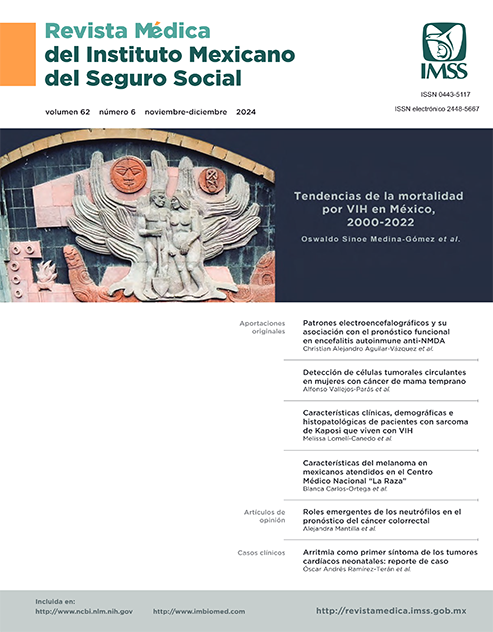Epidemiological and clinical aspects of Guilain-Barré syndrome, 2012-2022
Main Article Content
Keywords
Abstract
Background: Guillain-Barré syndrome (GBS) is an immune- mediated polyradiculoneuropathy, generally post-infectious, and is the leading cause of acute flaccid paralysis worldwide.
Objective: To describe the epidemiological, clinical and behavioral characteristics of Guillain-Barré syndrome.
Material and methods: An observational, cross-sectional and descriptive study was carried out. The records of all patients with GBS from 2012-2022 were reviewed, and information on epidemiological and clinical variables was obtained. The incidence was calculated for each of the study years and the trend for the study period using the Pearson correlation coefficient, considering p ≤ 0.05 statistically significant.
Results: A total of 477 cases were obtained, 67% were men, among the comorbidities, drug addictions were present in 31% of the cases. Most cases were preceded by a gastrointestinal infectious condition. The most common phenotype was acute motor axonal neuropathy. 29% showed up in summer. A statistically significant tendency to increase was observed (p ≤ 0.05) and a mortality of 2.5% with predominance in the axonal variety.
Conclusions: The results of this study cover a relatively long period compared to other reviews, the findings agree with previous studies. GBS showed a statistically significant tendency to increase.
References
Shahrizaila N, Lehmann HC, Kuwabara S. Guillain-Barré syndrome. Lancet. 2021;397(10280):1214-1228. doi: 10.1016/S0140-6736(21)00517-1.
Sheikh KA. Guillain-Barré Syndrome. Continuum. 2020;26(5): 1184-1204. doi: 10.1212/CON.0000000000000929.
Wachira VK, Farinasso CM, Silva RB, et al. Incidence of Guillain- Barré syndrome in the world between 1985 and 2020: A systematic review. Glob Epidemiol. 2023;5:100098. doi: 10.1016/j.gloepi.2023.100098.
Abolmaali M, Rezania F, Behnagh AK, et al. Guillain-Barré syndrome in association with COVID-19 vaccination: a systematic review. Immunol Res. 2022;70(6):752-764. doi: 10.1007/s12026-022-09316-6.
Malek E, Salameh J. Guillain-Barre Syndrome. Semin Neurol. 2019;39(5):589-595. doi: 10.1055/s-0039-1693005.
Huang C, Zhang Y, Deng S, et al. Trauma-Related Guillain- Barré Syndrome: Systematic Review of an Emerging Concept. Front Neurol. 2020;11:588290. doi: 10.3389/fneur.2020. 588290.
Langille MM. Guillain-Barre Syndrome in Children and Adolescents. Adv Pediatr. 2023;70(1):91-103. doi: 10.1016/j.yapd. 2023.04.001.
Moscona-Nissan A Sr., López-Hernández JC, Seidman-Sorsby A, et al. Pharyngeal-Cervical-Brachial Variant of Guillain- Barré Syndrome. Cureus. 2021;13(10):e18788. doi: 10.7759/cureus.18788.
Organización Panamericana de la Salud. Clasificación Estadística Internacional de Enfermedades y Problemas Relacionados con la Salud. Décima Revisión. Washington DC, USA; 2008.
Secretaría de Salud, Dirección General de Epidemiología. Manual de Procedimientos Estandarizados para la Vigilancia Epidemiológica de Eventos Supuestamente Atribuibles a la Vacunación o Inmunización (ESAVI). Ciudad de México, México, 2022.
Nagappa M, Wahatule R, Bindu PS, et al. Spectrum of Sensory Conduction Abnormalities in Guillain Barre Syndrome. Neurol India. 2022;70(6):2393-2400. doi: 10.4103/0028-3886.364073.
McCombe PA, Hardy TA, Nona RJ, et al. Sex differences in Guillain Barré syndrome, chronic inflammatory demyelinating polyradiculoneuropathy and experimental autoimmune neuritis. Front Immunol. 2022;13:1038411. doi: 10.3389/fimmu.2022.1038411.
Al-Hayk K, Aqileh S, Smadi MM, et al. Clinical characteristics and management outcomes of Guillain-Barré syndrome: eightyear experience at a tertiary center in jordan - a retrospective cohort study. Ann Med Surg (Lond). 2023;85(7):3298-3302. doi: 10.1097/MS9.0000000000000869.
Ryan L, Mills KHG. Sex differences regulate immune responses in experimental autoimmune encephalomyelitis and multiple sclerosis. Eur J Immunol. 2022;52(1):24-33. doi: 10.1002/eji.202149589.
Ding Y, Wang L, Sun J, et al. Remnant Cholesterol and Dyslipidemia Are Risk Factors for Guillain-Barré Syndrome and Severe Guillain-Barré Syndrome by Promoting Monocyte Activation. Front Immunol. 2022;13:946825. doi: 10.3389/fimmu.2022.946825.
López-Hernández JC, Colunga-Lozano LE, Garcia-Trejo S, et al. Electrophysiological subtypes and associated prognosis factors of Mexican adults diagnosed with Guillain-Barré syndrome, a single center experience. J Clin Neurosci. 2020;80: 292-297. doi: 10.1016/j.jocn.2020.04.059.
Galnares-Olalde JA, López-Hernández JC, García-Grimshaw M, et al. Guillain-Barré Syndrome in Mexico: An Updated Review Amid the Coronavirus Disease 2019 ERA. Rev Invest Clin. 2022;74(3):121-130. doi: 10.24875/RIC.22000006.
Munayco CV, Soto-Cabezas MG, Reyes MF, et al. Epidemiología del síndrome de guillain-barré en el Perú. Rev Peru Med Exp Salud Publica. 2019;36(1):10-16. doi: 10.17843/rpmesp.2019.361.3729.
Cabrera-Ortiz A, álvarez-Aguilar P, Porras-Vargas J. Caracterización clínica del síndrome de Guillain-Barré en el Hospital México, Costa Rica. Rev Hisp Cienc Salud. 2019;5(2):55-62.
Olaiz-Fernández GA, Gómez-Peña EG, Juárez-Flores A, et al. Panorama histórico de la enfermedad diarreica aguda en México y el futuro de su prevención. Salud Publica Mex. 2020;62 (1):25-35. doi: 10.21149/10002.
Leonhard SE, van der Eijk AA, Andersen H, et al. An International Perspective on Preceding Infections in Guillain-Barré Syndrome: The IGOS-1000 Cohort. Neurology. 2022;99(12):e1299- e1313. doi: 10.1212/WNL.0000000000200885.
Gao Y, Chen Y, Shi P, et al. The Effect of Ambient Temperature on Infectious Diarrhea and Diarrhea-like Illness in Wuxi, China. Disaster Med Public Health Prep. 2022;16(2):583-589. doi: 10.1017/dmp.2020.340.
Doets AY, Lingsma HF, Walgaard C, et al. Predicting Outcome in Guillain-Barré Syndrome: International Validation of the Modified Erasmus GBS Outcome Score. Neurology. 2022;98(5): e518-e532. doi: 10.1212/WNL.0000000000013139.
Kim AY, Lee H, Lee YM, et al. Epidemiological Features and Economic Burden of Guillain-Barré Syndrome in South Korea: A Nationwide Population-Based Study. J Clin Neurol. 2021;17 (2):257-264. doi: 10.3988/jcn.2021.17.2.257.
Levison LS, Thomsen RW, Christensen DH, et al. Guillain- Barré syndrome in Denmark: validation of diagnostic codes and a population-based nationwide study of the incidence in a 30-year period. Clin Epidemiol. 2019;11:275-283. doi: 10.2147/CLEP.S199839.
López-Hernández JC, Pérez-Valdez EY, León-Manríquez E, et al. Guillain-Barre syndrome during COVID-19 pandemic: experience from a referral healthcare center in Mexico. Rev Neurol. 2021;73(9):315-320. doi: 10.33588/rn.7309.2021364.
Shang P, Zhu M, Wang Y, et al. Axonal variants of Guillain- Barré syndrome: an update. J Neurol. 2021;268(7):2402-2419. doi: 10.1007/s00415-020-09742-2.
Leonhard SE, Mandarakas MR, Gondim FAA, et al. Diagnosis and management of Guillain-Barré syndrome in ten steps. Nat Rev Neurol. 2019;15(11):671-683. doi: 10.1038/s41582-019-0250-9.


